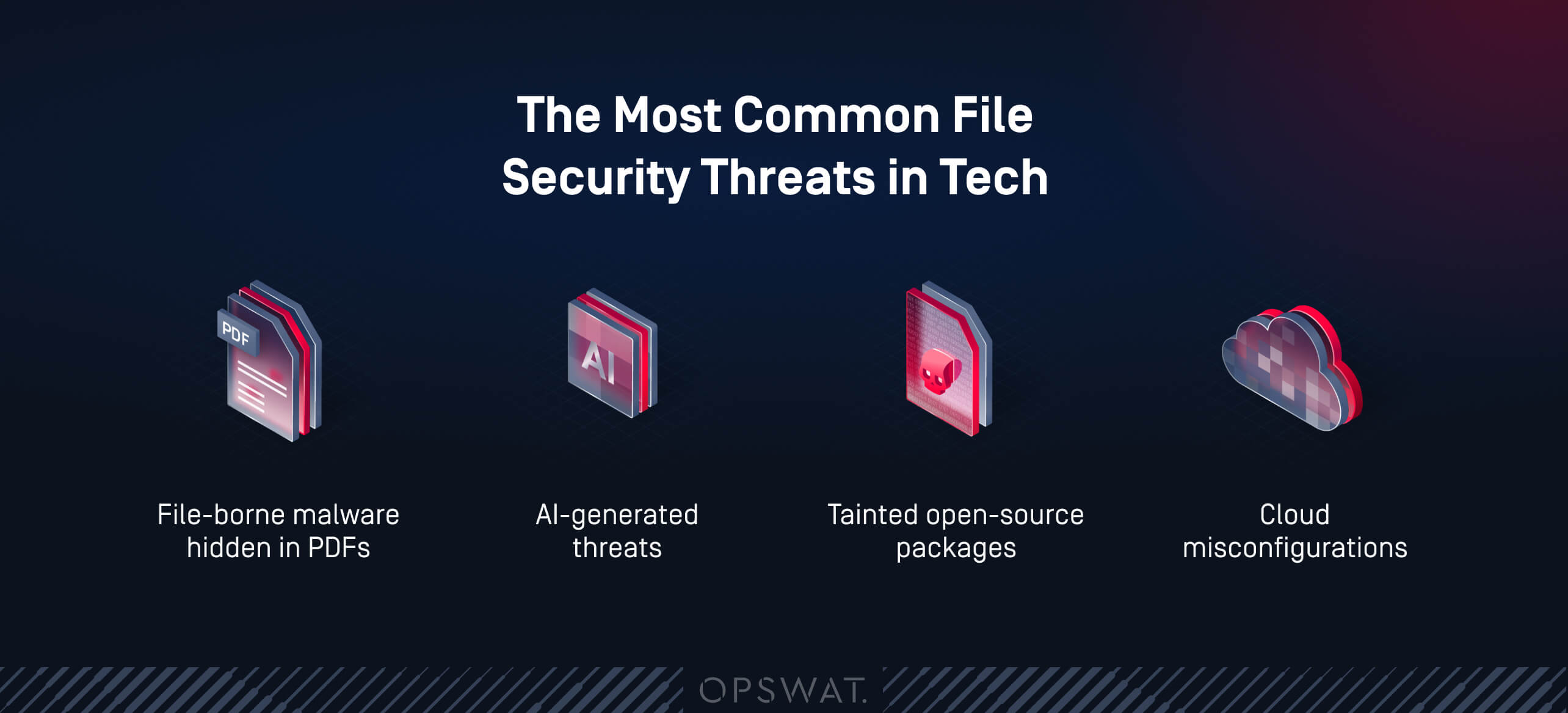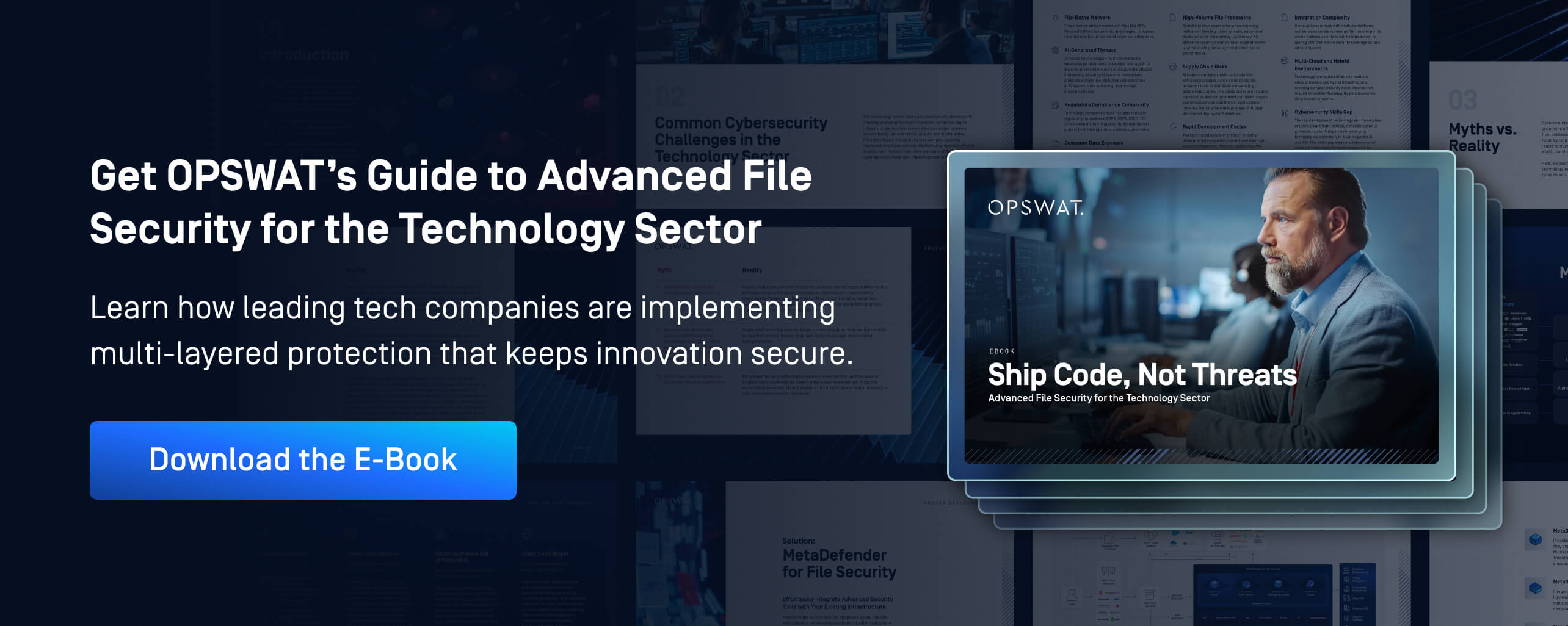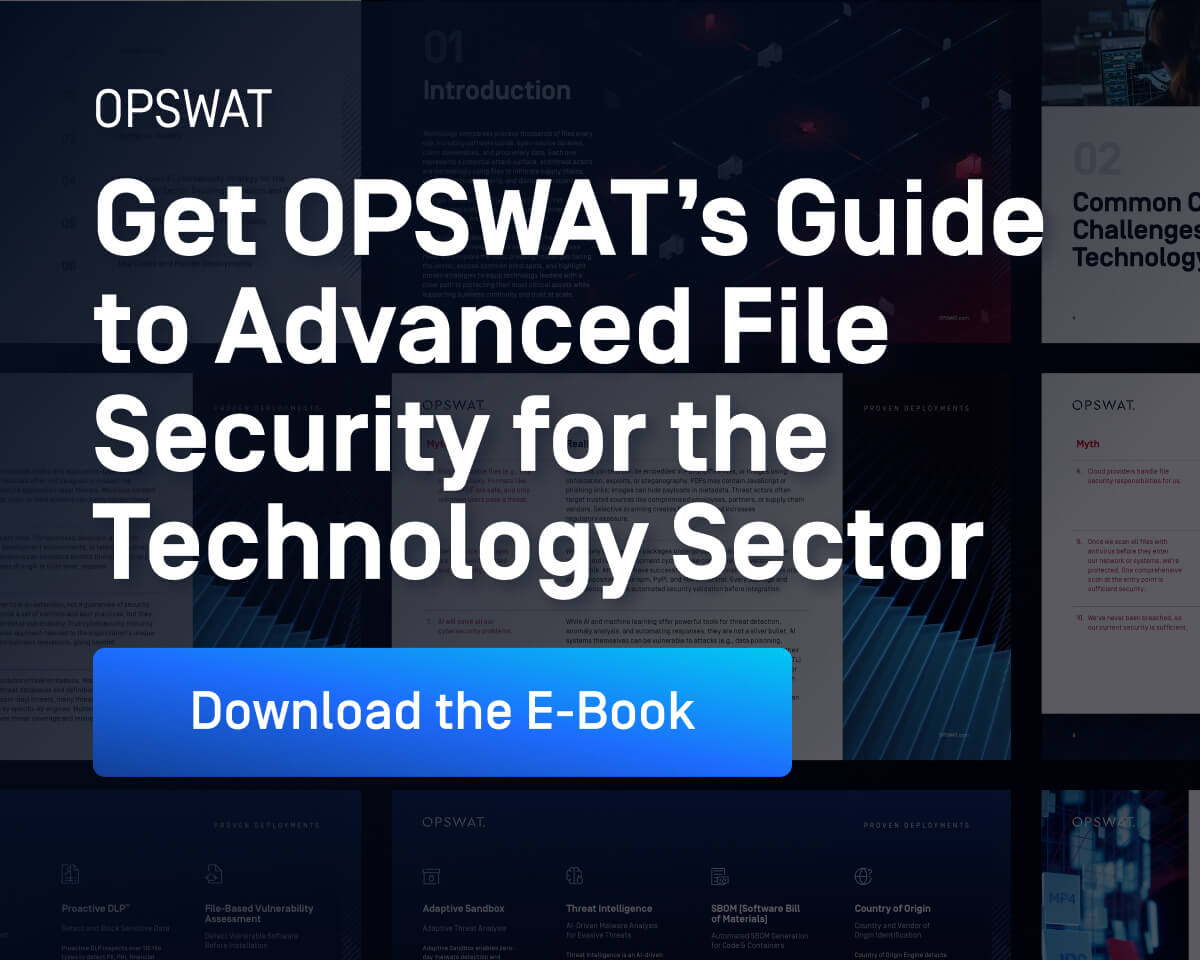Why File Security Is Critical for Technology Companies
In the technology sector, files power CI/CD pipelines, cloud applications, and customer workflows. But these same files are increasingly weaponized.
With over 95% of codebases containing open-source components and average breach costs surpassing $4.7M, it takes only one tainted file to cascade risk across environments before anyone notices.
Modern development speed and interconnected systems have outpaced traditional defenses. To stay competitive, technology companies must adopt file security strategies that scale with cloud velocity while maintaining zero-trust assurance.
The Most Common File Security Threats in Tech
- File-borne malware hidden in PDFs, archives, and Office docs bypasses perimeter checks.
- AI-generated threats accelerate phishing, evasion, and polymorphic malware creation.
- Tainted open-source packages introduce hidden exploits into dependency chains.
- Cloud misconfigurations and multi-tenant exposure propagate risk across hybrid environments.

From File Risk to Business and Compliance Exposure
Unchecked file movement creates a domino effect: data theft, downtime, and regulatory non-compliance. Frameworks like SOC 2, ISO 27001, and GDPR all demand evidence of file governance, encryption, and audit trails.
Falling short not only triggers compliance penalties but also undermines trust with partners and customers.
Why Perimeter Defenses Aren’t Enough
Firewalls and endpoint AV are necessary, but not sufficient. They rarely analyze the embedded content inside files moving through CI/CD pipelines, S3 buckets, or API uploads. In modern distributed systems, files move faster than traditional inspection points, leaving unseen gaps for attackers to exploit.
Dispelling the Top File Security Myths in the Tech Industry
Even advanced tech organizations often operate under misconceptions that quietly increase exposure. Let’s separate myth from reality.
Myth 1: “Firewalls and cloud providers handle file security.”
Cloud providers protect the platform, not your file content. Under the shared responsibility model, you own data and file inspection across uploads, buckets, and APIs.
Myth 2: “Only external files need scanning.”
Internal uploads like developer commits, support artifacts, or model updates can introduce risk from compromised accounts or insider threats. Every file must be validated, regardless of origin.
Myth 3: “Compliance equals security.”
Regulations set a baseline. Effective file security requires continuous monitoring, automated audit trails, and risk-based controls that go beyond simple checklists.
Myth 4: “One antivirus engine is enough.”
Attackers design payloads to evade single-engine AV. Metascan™ Multiscanning, which combines 30+ commercial engines, offers far stronger detection and resilience.
Myth 5: “Non-executable files are safe.”
PDFs, Office files, and images can contain active content or embedded scripts. Every file format needs equal scrutiny.
Best Practices for Securing Files Across CI/CD, S3, and Hybrid Cloud
A modern file security strategy protects data at ingest, process, store, and distribute stages—without introducing friction.
Secure File Uploads in SaaS and Portals
Implement real-time scanning, CDR (content disarm and reconstruction), and DLP (data loss prevention) at every upload point. Early inspection stops threats before they propagate downstream.
Scan Files in AWS S3 and Cloud Storage
Use on-write and on-read scanning to detect threats at rest. Apply quarantine and provenance tagging to maintain traceability and automate response across multi-cloud storage.
Integrate File Scanning in CI/CD Pipelines
Embed multiscanning, CDR, and SBOM checks in Jenkins, GitLab, or GitHub Actions. This ensures clean builds and dependency integrity without slowing release cadence.
Monitor File Activity Across Environments
Establish audit trails, RBAC (role-based access controls), and SIEM integration for end-to-end visibility. Continuous telemetry turns file security from reactive to predictive.
Comparing Advanced File Security Technologies
| Tecnologia | Primary Function | Punti di forza | Limitazioni |
|---|---|---|---|
| Antivirus (AV) | Detects known malware signatures | Quick and lightweight | Evasion-prone, limited scope |
| Multiscanning | Uses multiple AV engines for redundancy | High detection coverage | Needs orchestration |
| CDR | Sanitizes active content in files | Removes zero-day exploits | May alter file fidelity |
| DLP | Prevents data leakage (PII, secrets) | Compliance enabler | Requires policy tuning |
| SBOM | Inventories software components | Enables supply chain visibility | Needs integration |
| Sandboxing | Executes suspicious files safely | Identifies unknown threats | Resource-intensive |
A multi-layered stack combining these technologies delivers the strongest protection and compliance coverage for modern DevOps workflows.
Aligning File Security with SOC 2, ISO 27001, and GDPR
Security architects must align file security with evolving compliance frameworks.
- SOC 2: Requires proof of control effectiveness, including logging, scanning, and data retention.
- ISO 27001: Calls for defined risk management, asset inventory, and secure storage.
- GDPR: Demands data minimization, encryption, and breach response transparency.
Automation is key. MetaDefender audit logs, CMDB connectors, and SIEM integrations generate evidence automatically, simplifying audits and compliance reviews.
Proven File Security Deployment Blueprints
Across hundreds of customers, OPSWAT MetaDefender has delivered measurable results in the field:
- HiBob secured S3 uploads, cutting malware risk while preserving user experience.
- FastTrack Software blocked risky admin installs during deployment.
- A global engineering leader gained real-time visibility using API-driven S3 onboarding and Splunk logging.
- A SaaS provider scaled to 6,000+ daily Kubernetes scans with zero data persistence.
Outcomes include faster triage, audit-ready releases, and improved developer velocity without trade-offs.
How the OPSWAT MetaDefender Platform Empowers Tech Companies to Ship Code, Not Threats
The MetaDefender Platform unifies multiscanning, CDR, DLP, sandboxing, SBOM, and threat intelligence in a zero-trust framework.
It protects every stage of the file lifecycle:
- Ingest – Validate and sanitize uploads via MetaDefender ICAP Server™.
- Process – Integrate scanning and SBOM checks into CI/CD pipelines.
- Store – Enforce on-write/on-read scanning in MetaDefender Storage Security™.
- Distribute – Ensure clean, signed, and auditable release artifacts.
At its core, the MetaDefender Platform offers a cohesive, scalable defense framework for cloud-native architectures.
Principali risultati
Technology companies can no longer rely on legacy controls. File security must be integrated, automated, and continuous, from upload to release.
With the MetaDefender Platform, you can protect every file path, aid compliance, and keep your development fast, secure, and fortified against advanced threats in 2026 and beyond.



